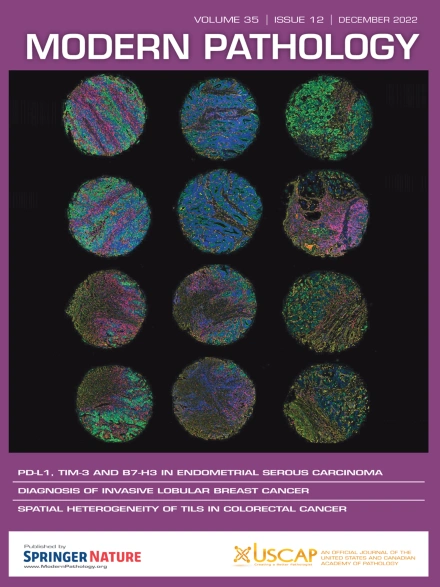Spatially Resolved Single-Cell Transcriptome Analysis of Mycosis Fungoides Reveals Distinct Biomarkers GNLY and FYB1 Compared With Psoriasis and Chronic Spongiotic Dermatitis
IF 7.1
1区 医学
Q1 PATHOLOGY
引用次数: 0
Abstract
Early mycosis fungoides (MF) and inflammatory dermatoses including psoriasis and chronic spongiotic dermatitis are often difficult to differentiate. We explored diagnostic markers differentiating MF from psoriasis and chronic spongiotic dermatitis via spatially resolved single-cell transcriptome analysis. Single-cell transcriptomics of intraepidermal T cells of MF patches, psoriasis, and chronic spongiotic dermatitis were analyzed using CosMx spatial molecular imager utilizing surface markers, including CD3 and CD4. An immunohistochemical study with potential markers was performed to verify clinical utility. Compared with psoriasis and chronic spongiotic dermatitis, 41 upregulated differentially expressed genes (DEGs) in MF were associated with the T-cell receptor (TCR) signaling pathway and apoptosis regulation. Protein–protein interaction network analysis of these DEGs revealed a main cluster associated with TCR signaling. Pathway enrichment analysis showed that apoptosis, Th17 cell differentiation, and TCR signaling pathways were enriched in MF. GNLY and FYB1, DEGs with the highest fold-change values, were selected as potential diagnostic biomarkers for MF. For immunohistochemistry, biopsy specimens from 150 patients diagnosed with patch MF with CD4+ immunophenotype (n = 56), psoriasis (n = 48), and chronic eczema (n = 46) were included. The sensitivity and specificity of granulysin (GNLY) for distinguishing MF and psoriasis/chronic spongiotic dermatitis were 67.9% and 93.6%, respectively. For FYN-binding protein 1 (FYB1), those values were 73.2% and 69.2%, respectively. The area under the receiver operating characteristic curve values of GNLY and FYB1 were 0.86 and 0.79, respectively. In conclusion, granulysin and FYB1 can be promising diagnostic biomarkers for differentiating early-stage MF from psoriasis and chronic spongiotic dermatitis.
对真菌病的空间分辨单细胞转录组分析显示,与银屑病和慢性海绵状皮炎相比,GNLY 和 FYB1 是独特的生物标记物。
早期蕈样真菌病(MF)和炎性皮肤病(包括牛皮癣和慢性海绵性皮炎)通常难以区分。我们通过单细胞转录组分析探索了MF与牛皮癣和慢性海绵性皮炎的诊断标记。应用CosMxTM空间分子成像仪利用CD3和CD4等表面标记物分析MF斑块、银屑病和慢性海绵性皮炎表皮内T细胞的单细胞转录组学。对潜在标记物进行了免疫组织化学研究,以验证其临床应用。与银屑病和慢性海绵性皮炎相比,MF中41个差异表达基因(DEGs)上调与t细胞受体(TCR)信号通路和细胞凋亡调控相关。这些deg的蛋白-蛋白相互作用网络分析揭示了一个与TCR信号相关的主要簇。通路富集分析显示,MF中凋亡、Th17细胞分化和TCR信号通路富集。选择具有最高倍数变化值的deg GNLY和FYB1作为MF的潜在诊断生物标志物。在免疫组织化学方面,纳入了150例诊断为CD4+免疫表型贴片MF (n = 56)、牛皮癣(n = 48)和慢性湿疹(n = 46)患者的活检标本。GNLY鉴别MF与银屑病/慢性海绵性皮炎的敏感性和特异性分别为67.9%和93.6%。对于FYB1,这些值分别为73.2%和69.2%。GNLY和FYB1的AUC值分别为0.86和0.79。总之,GNLY和FYB1可以作为早期MF与银屑病和慢性海绵性皮炎鉴别的有希望的诊断生物标志物。
本文章由计算机程序翻译,如有差异,请以英文原文为准。
求助全文
约1分钟内获得全文
求助全文
来源期刊

Modern Pathology
医学-病理学
CiteScore
14.30
自引率
2.70%
发文量
174
审稿时长
18 days
期刊介绍:
Modern Pathology, an international journal under the ownership of The United States & Canadian Academy of Pathology (USCAP), serves as an authoritative platform for publishing top-tier clinical and translational research studies in pathology.
Original manuscripts are the primary focus of Modern Pathology, complemented by impactful editorials, reviews, and practice guidelines covering all facets of precision diagnostics in human pathology. The journal's scope includes advancements in molecular diagnostics and genomic classifications of diseases, breakthroughs in immune-oncology, computational science, applied bioinformatics, and digital pathology.
 求助内容:
求助内容: 应助结果提醒方式:
应助结果提醒方式:


